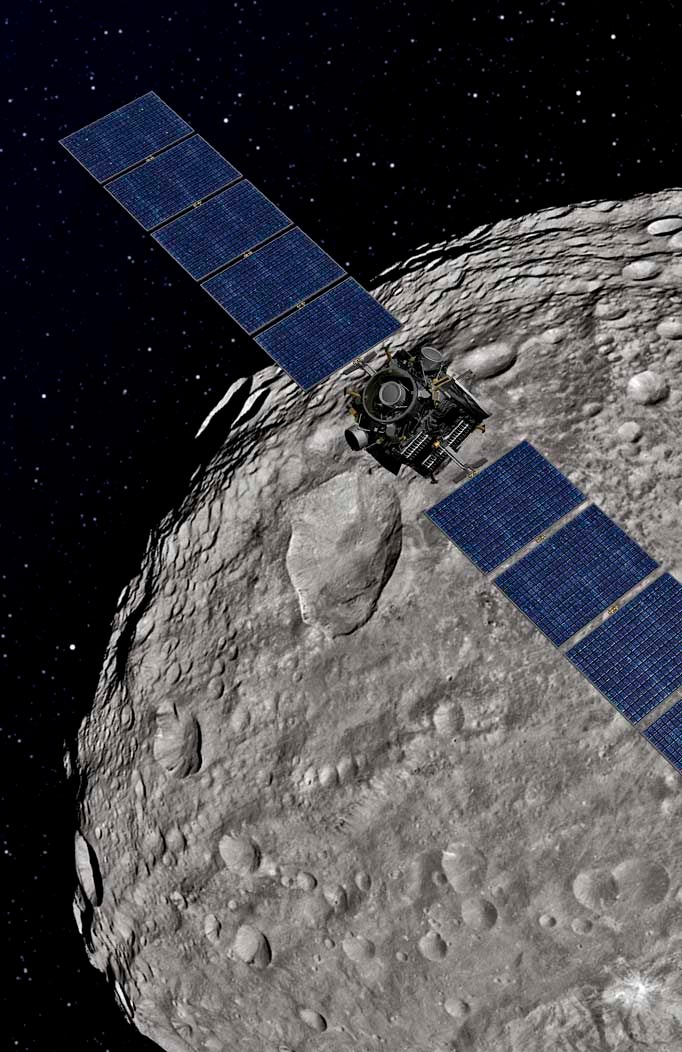Engineers were able to return the spacecraft to a normal configuration and restart its thrusting June 30 by switching to a second digital control and interface unit with equivalent capabilities. One set of images for navigation purposes was not obtained June 28 because the spacecraft was in safe-communications mode, and one other set, on July 6, was not obtained to allow the spacecraft to spend the time thrusting. Other sets of navigation images have been and will be acquired as expected. The ion propulsion system is now functioning normally.
“Dawn is still on track to get into orbit around Vesta, and thanks to the flexibility provided by our use of ion propulsion, the time of orbit capture actually will move earlier by a little less than a day,” said Marc Rayman, Dawn’s chief engineer and mission manager. “More importantly, the rest of Dawn’s schedule is unaffected, and science collection is expected to begin as scheduled in early August.”
In an unrelated event, the visible and infrared mapping spectrometer on Dawn reset itself June 29. At the time of the reset, the instrument was gathering calibration data during the spacecraft’s approach to the giant asteroid Vesta. Some of its planned observations were completed successfully before automatic sensors turned the instrument off.
On June 30, Dawn team members were able to trace the reset to an internal error in the instrument’s central processing unit, though they don’t yet know why the internal error occurred. By temporarily turning the instrument back on, the Dawn team confirmed that the instrument is otherwise in a normal configuration. They powered the instrument back off, as originally planned for this time. Team members are working to determine when they will turn it back on again.
After arriving at Vesta, Dawn will spend about one year orbiting the asteroid, which is also known as a protoplanet because it is a large body that almost became a planet. Data collected at Vesta will help scientists understand the earliest chapter of our solar system’s history.
Engineers were able to return the spacecraft to a normal configuration and restart its thrusting June 30 by switching to a second digital control and interface unit with equivalent capabilities. One set of images for navigation purposes was not obtained June 28 because the spacecraft was in safe-communications mode, and one other set, on July 6, was not obtained to allow the spacecraft to spend the time thrusting. Other sets of navigation images have been and will be acquired as expected. The ion propulsion system is now functioning normally.
“Dawn is still on track to get into orbit around Vesta, and thanks to the flexibility provided by our use of ion propulsion, the time of orbit capture actually will move earlier by a little less than a day,” said Marc Rayman, Dawn’s chief engineer and mission manager. “More importantly, the rest of Dawn’s schedule is unaffected, and science collection is expected to begin as scheduled in early August.”
In an unrelated event, the visible and infrared mapping spectrometer on Dawn reset itself June 29. At the time of the reset, the instrument was gathering calibration data during the spacecraft’s approach to the giant asteroid Vesta. Some of its planned observations were completed successfully before automatic sensors turned the instrument off.
On June 30, Dawn team members were able to trace the reset to an internal error in the instrument’s central processing unit, though they don’t yet know why the internal error occurred. By temporarily turning the instrument back on, the Dawn team confirmed that the instrument is otherwise in a normal configuration. They powered the instrument back off, as originally planned for this time. Team members are working to determine when they will turn it back on again.
After arriving at Vesta, Dawn will spend about one year orbiting the asteroid, which is also known as a protoplanet because it is a large body that almost became a planet. Data collected at Vesta will help scientists understand the earliest chapter of our solar system’s history.










